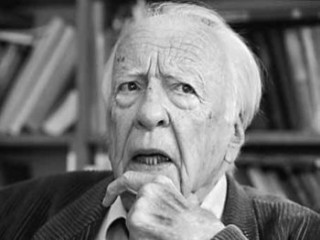
Hans-Georg Gadamer biography
Date of birth : 1900-02-11
Date of death : 2002-03-13
Birthplace : Marburg, Germany
Nationality : German
Category : Famous Figures
Last modified : 2011-06-07
Credited as : Philosopher, interpretation theorist , Wahrheit und Methode (Truth and Method)
German philosopher, classicist, and interpretation theorist Hans-Georg Gadamer was the leading exponent of a comprehensive view of human beings as dialogue-partners with each other.
Gadamer was born in Marburg, Germany, son of a well-known professor of chemistry. His university studies at Breslau, Marburg, and Munich included ancient and modern languages and literature, history, art history, and philosophy. Further studies with Martin Heidegger led to the publication of his Habilitation in 1929, qualifying him to teach at a university. He taught at the Universities of Marburg, Kiel, Leipzig (where he was Rektor in 1946-1947), Frankfurt, and Heidelberg (where he succeeded Karl Jaspers in 1949 and was professor of philosophy until formal retirement in 1968). He married Kaete Lekebusch in 1950, and they had one daughter.
From his work as a teacher, his many writings, and his appearances and teaching abroad, Gadamer acquired a world reputation. His major work, Wahrheit und Methode (1960; translated as Truth and Method, 1975), was prepared for publication at the urging of students who first encountered his ideas in classes and seminars.
One of the few major German intellectuals to remain in Germany during the Hitler period and yet keep his distance from the Nazis, Gadamer represents the continuity of a European tradition linking the intellectual excitement of the 1920s to the 1960s, 1970s, and 1980s. Heidegger, Gadamer's teacher in the 1920s, was the greatest figure in existential philosophy, and Gadamer was closely associated with others who were to shape the course of theological, literary, and philosophical studies for decades to come. For today's students, Gadamer is a living witness of the vitality of the great teachers of his youth, as seen in his essays in Part II of Philosophical Hermeneutics (1976) and Philosophical Apprenticeships (1985).
Beginning in the 1950s, Gadamer himself represented a major position in philosophy of the humanities, counterposed to Marxists such as Jurgen Habermas, radically antimethodical interpreters such as Jacques Derrida, and the viewpoint represented by E.D. Hirsch that the meaning of a text is just what the author intended. Gadamer was the spokesperson for philosophical hermeneutics. The word "hermeneutics" has a long history in theology, literature, and the law. There it most frequently indicated an art of interpretation which could wrest secrets from difficult texts originally addressed to a past audience, such as the Bible. Following Heidegger's lead, Gadamer gave hermeneutics a broader meaning; it is a theory of human existence arising from study of the events of understanding and interpretation in which human beings are always involved.
Gadamer challenged the "scientific" view of the humanities which assumed that their task was to exploit methods, inspired by natural scientific method, to generate a single correct interpretation for every work. For Gadamer, the primary purpose of humanistic studies was deepening insight for the reader, viewer, or hearer. He focused on the dynamic by which the message of a work addresses its audience in his or her situation. The reader, he argued, never receives the message in precisely the same sense as the speaker's or author's intention, but always understands in ways shaped by prejudgments arising out of one's own experience and language-learning. Thus, nobody reads a text in precisely the same way as someone else. Differences will be especially significant when interpreters belong to different periods, since they will bring different questions and human interests to bear. The product will be the result of the "fusion of the horizons (or perspectives)" of the text and the interpreter.
But Gadamer did not propose an "anything goes" approach. Meaningful interpretation is limited by the fact that understanding always belongs to a tradition. The way conductors present a classical piece to contemporary audiences will be shaped not only by their perception of the audience's expectations, but also by inherited ways of interpreting the work and sets of assumptions, insights, and methods enriched, impoverished, and modified over the years. No one, Gadamer insisted, is immune to such an influence from the past. But a fresh interpretation becomes possible when an interpreter discovers some unexamined prejudgment at work, decides that it deserves to be challenged, and produces a new way of presenting the work. Moreover, the origin of the challenge may be the work itself. For Gadamer, a seminal work was a conversation-partner, a "Thou," addressing the self and calling its illegitimate biases into question.
Beginning in the 1970s Gadamer regularly taught part of the year in North America. He continued to pursue research, especially in classical Greek philosophy. He found that Plato's use of the dialogue form and Aristotle's description of moral insight suggest a viable alternative to the model of reason developed by uncritical admirers of the sciences of prediction and control. Some of his later work is available in Dialogue and Dialectic (1980), The Idea of the Good in Platonic-Aristotelian Philosophy (1986), and Reason in the Age of Science (1981).
















